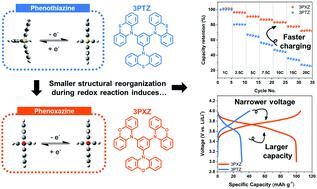当前位置:
X-MOL 学术
›
Energy Environ. Sci.
›
论文详情
Our official English website, www.x-mol.net, welcomes your
feedback! (Note: you will need to create a separate account there.)
Phenoxazine as a high-voltage p-type redox center for organic battery cathode materials: small structural reorganization for faster charging and narrow operating voltage
Energy & Environmental Science ( IF 32.4 ) Pub Date : 2020-06-23 , DOI: 10.1039/d0ee01003k Kyunam Lee 1, 2, 3, 4, 5 , Illia E. Serdiuk 1, 2, 3, 4, 5 , Giyun Kwon 3, 5, 6, 7, 8 , Dong Joo Min 1, 2, 3, 4, 5 , Kisuk Kang 3, 5, 6, 7, 8 , Soo Young Park 1, 2, 3, 4, 5 , Ji Eon Kwon 1, 2, 3, 4, 5
Energy & Environmental Science ( IF 32.4 ) Pub Date : 2020-06-23 , DOI: 10.1039/d0ee01003k Kyunam Lee 1, 2, 3, 4, 5 , Illia E. Serdiuk 1, 2, 3, 4, 5 , Giyun Kwon 3, 5, 6, 7, 8 , Dong Joo Min 1, 2, 3, 4, 5 , Kisuk Kang 3, 5, 6, 7, 8 , Soo Young Park 1, 2, 3, 4, 5 , Ji Eon Kwon 1, 2, 3, 4, 5
Affiliation

|
Although organic p-type cathode materials with high redox potential (>3.5 V vs. Li/Li+) are sustainable alternatives to transition metal oxide cathodes for lithium-ion batteries, only a limited number of these materials have been investigated to date. Therefore, the discovery of new p-type redox centers is essential for further development of successful organic cathodes. Herein, we report phenoxazine (PXZ) as a new p-type redox center for high-voltage cathode materials. Negligible structural reorganization of this PXZ center facilitates a kinetically faster electrochemical pathway, leading to a narrow voltage plateau, full utilization of the capacity, and superior rate capability in a new PXZ-based cathode material, PXZ trimer (3PXZ). The 3PXZ cathode delivered a specific capacity of 112 mA h g−1 at 1C with a high average discharge voltage of 3.7 V vs. Li/Li+ in a Li-organic cell; moreover, even at a high rate of 20C, 73% capacity retention (76 mA h g−1) was achieved. In addition, a 3PXZ composite with mesoporous carbon CMK-3 exhibited a capacity of 100 mA h g−1 with high stability, losing only 0.044% capacity per cycle over 500 cycles at 5C. As 3PXZ outperforms most reported p-type cathodes in terms of both rate capability and stability, we suggest the adoption of the PXZ unit as a novel and promising redox center for high-performance and sustainable energy storage systems.
中文翻译:

苯恶嗪作为有机电池正极材料的高压p型氧化还原中心:结构重组小,充电速度更快,工作电压更窄
尽管具有高氧化还原电势(> 3.5 V vs. Li / Li +)的有机p型阴极材料是锂离子电池过渡金属氧化物阴极的可持续替代品,但迄今为止,仅对其中几种材料进行了研究。因此,发现新的p型氧化还原中心对于进一步开发成功的有机阴极至关重要。在本文中,我们报告了吩恶嗪(PXZ)作为高压阴极材料的新型p型氧化还原中心。该PXZ中心的结构重组可忽略不计,从而促进了动力学上更快的电化学途径,从而导致电压平台更窄,容量的充分利用以及新型PXZ的超高倍率性能阴极材料,PXZ三聚体(3PXZ)。所述3PXZ阴极递送112毫安Hg的比容量-1在1C与3.7伏特的高平均放电电压与对于Li / Li +在Li-有机细胞; 此外,即使在20℃的高速率下,也实现了73%的容量保持率(76mA hg -1)。另外,具有中孔碳CMK-3的3PXZ复合材料表现出100mA hg -1的容量和高稳定性,在5℃下500次循环中每循环仅损失0.044%。作为3PXZ在速率能力和稳定性方面都胜过大多数报道的p型阴极,我们建议采用PXZ单元作为高性能和可持续储能系统的新型且有希望的氧化还原中心。
更新日期:2020-06-30
中文翻译:

苯恶嗪作为有机电池正极材料的高压p型氧化还原中心:结构重组小,充电速度更快,工作电压更窄
尽管具有高氧化还原电势(> 3.5 V vs. Li / Li +)的有机p型阴极材料是锂离子电池过渡金属氧化物阴极的可持续替代品,但迄今为止,仅对其中几种材料进行了研究。因此,发现新的p型氧化还原中心对于进一步开发成功的有机阴极至关重要。在本文中,我们报告了吩恶嗪(PXZ)作为高压阴极材料的新型p型氧化还原中心。该PXZ中心的结构重组可忽略不计,从而促进了动力学上更快的电化学途径,从而导致电压平台更窄,容量的充分利用以及新型PXZ的超高倍率性能阴极材料,PXZ三聚体(3PXZ)。所述3PXZ阴极递送112毫安Hg的比容量-1在1C与3.7伏特的高平均放电电压与对于Li / Li +在Li-有机细胞; 此外,即使在20℃的高速率下,也实现了73%的容量保持率(76mA hg -1)。另外,具有中孔碳CMK-3的3PXZ复合材料表现出100mA hg -1的容量和高稳定性,在5℃下500次循环中每循环仅损失0.044%。作为3PXZ在速率能力和稳定性方面都胜过大多数报道的p型阴极,我们建议采用PXZ单元作为高性能和可持续储能系统的新型且有希望的氧化还原中心。











































 京公网安备 11010802027423号
京公网安备 11010802027423号